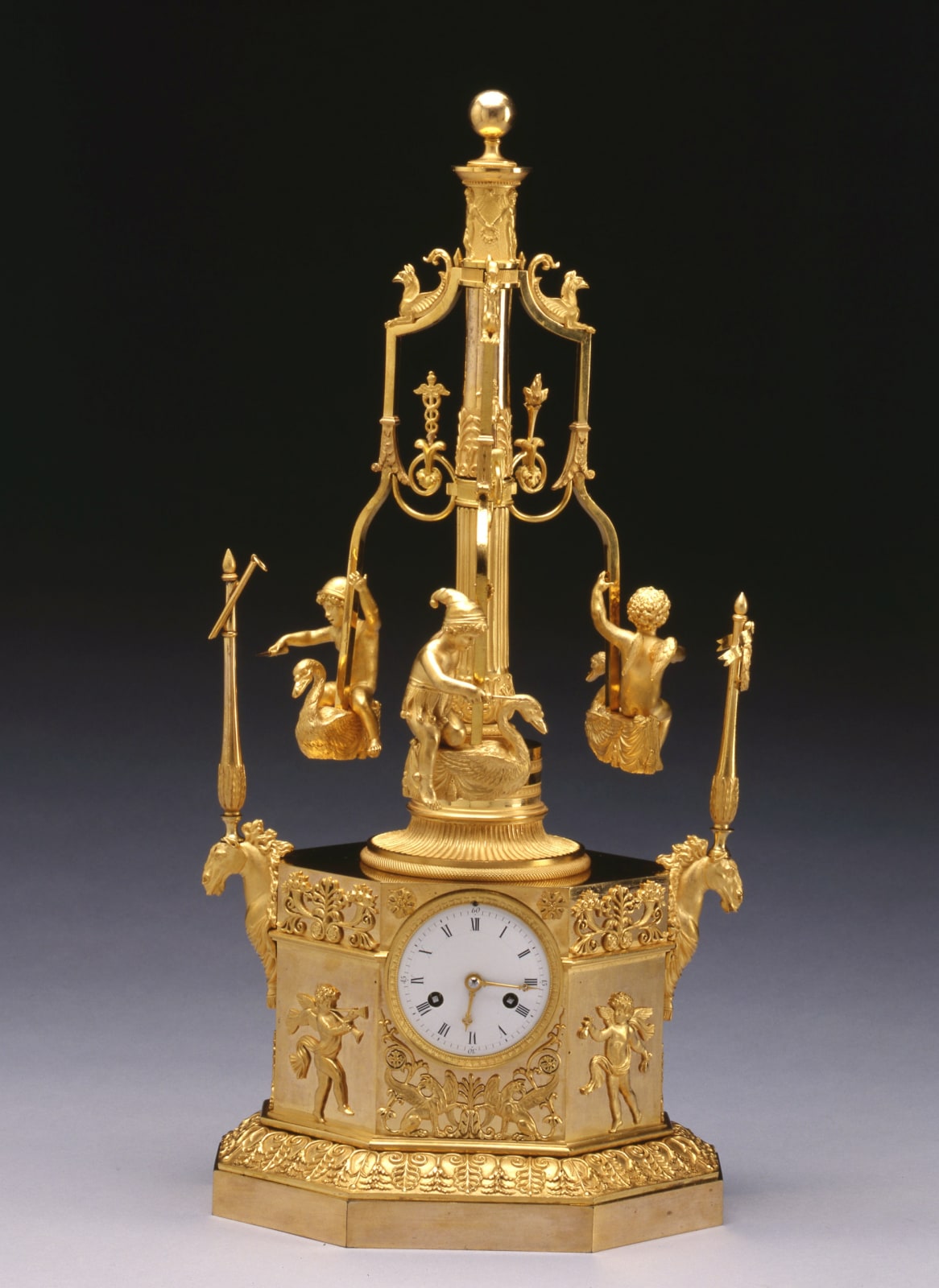Louis-Jacques Vaillant
Provenance
Valtesse de la Bigne, Ville d'Avray.
Literature
Pierre Kjellberg, "Encyclopédie de la Pendule Française du Moyen Age au XXe Siècle", 1997, p. 447, pl. F, illustrating and almost identical clock with a patinated and gilt mounted base.
A very rare Restauration gilt bronze automaton 'Pendule au Manège' by Louis-Jacques Vaillant, signed on the backplate of the movement V and inscribed on the pendulum bob Valtesse de la Bigne Ville d'Avray. The white enamel dial with Roman numerals and a pair of gilt brass hands for the hours and minutes. The automaton movement activated on the hour rotating the carousel for several minutes. The dial mounted on a stepped hexagonal base chased with palmettes, griffins and infant musicians and mounted by horse heads, the base surmounted by a part-fluted column on a circular foot, chased with anthemion and putti and headed by a sphere. The central column supporting a three-branch carousel, headed by griffins and supporting three swans ridden by an infant Mercury, an infant Cupid and an infant jester
Paris, date circa 1815-30
Height 50 cm, width 25 cm, depth 17 cm.
An identical clock was made for the Austro-Hungarian prince, Count Nikolaus Esterhazy (1765-1833), who was a brilliant soldier and important patron of the arts, while another model was once in the collection of the Marquis of Tweedale. The name of Louis-Jacques Vaillant (d. after 1817) is generally associated with this clock model; sometimes his name appeared on the dial and in other instances, such as here, with his initial on the backplate. Vaillant was received as a Parisian maître-horloger in February 1787 and in 1789 was established at rue du Four-Saint-Honoré and then in 1800 at rue de la Tixanderie.
Knowing who owned a work generally enhances an object's value and certainly adds to its interest. Thus it is exciting to find the name of Valtesse de la Bigne inscribed upon the pendulum bob. The comtesse Valtesse, previously known as Lucie Delabigne (1859-1910) was a fashionable Parisian courtesan, who amassed a large art collection. She was befriended and portrayed by many of the Impressionists and their circle, while her bedroom served as a model for Emile Zola's scandalous novel Nana of 1880. Her sumptuous gilt bronze ceremonial bed, aptly decorated with flaming urns around the balustrade and Cupids on the headboard (and recently exhibited at the Birmingham Museum of Art, U.S.A.) was the only item from her vast collection donated to the Musée des Arts Décoratifs, Paris.
Originally from Normandy, Lucie Delabigne travelled to Paris to seek her fortune. When first she appeared on stage as Hebe in 'Orpheus in Hell', one critic described her as timid and redheaded as a Titian Virgin. This was perhaps an inappropriate analogy since after ruining one lover she found favour with Prince Lubomirski. She then became the mistress of Baron Sagan, who financed a glorious mansion built for her in 1876 by Jules Février on the corner of Blvd. Malesherbes and rue de la Terrasse. Valtesse also had a mansion just west of Paris and close to Sèvres at Ville d'Avray, where the present clock once stood and where she once gave sanctuary to her friend Liane de Pougy (1870-1950). The latter, a notorious courtesan, once a dancer at the Folies-Bergère and then finally a nun, noted in her recently published diaries, known as "The Blue Notebooks", that while fleeing her husband she hid at Valtesse's mansion in darkest Ville d'Avray.
Valtesse was not only known for her beauty but also for her intelligence and interest in the arts. Her circle of friends included a number of painters such as Gustave Courbet, Eugène Boudin, Alphonse de Neuville, Edouard Détaille and Edouard Manet, whose drawing of her is now in the Metropolitan Museum, New York. She was also the subject of portraits by Jean-Louis Forain and Détaille and was painted by Henri Gervex as the model for his bride in the painting 'Le Mariage Civil' (Salle de Mariage in the Mairie of the 19th Arrondissement, Paris).
Given her nature, Valtesse would have delighted in owning the present clock. Unusual in its style, it was formed as a fairground carousel and thus was decorated with horse heads and fantastic creatures in addition to the lesser-related classical motifs. The riders, each with appropriate attributes above, represent the infant figures of Mercury - the messenger god, Cupid - mythological god of love and a young jester, who when personified as Folly was often linked with Love.
